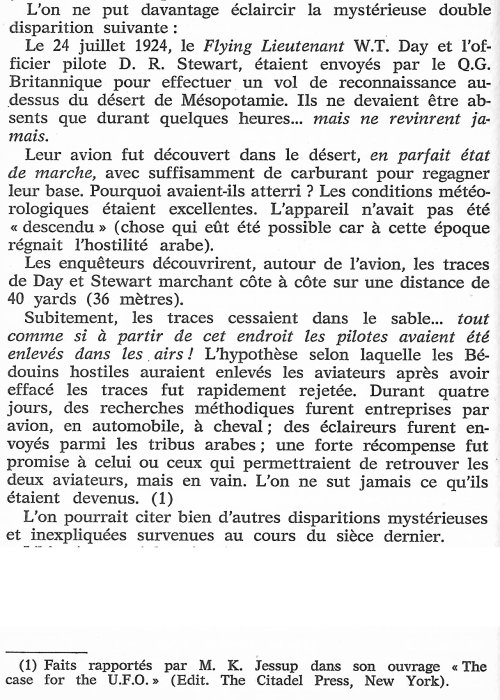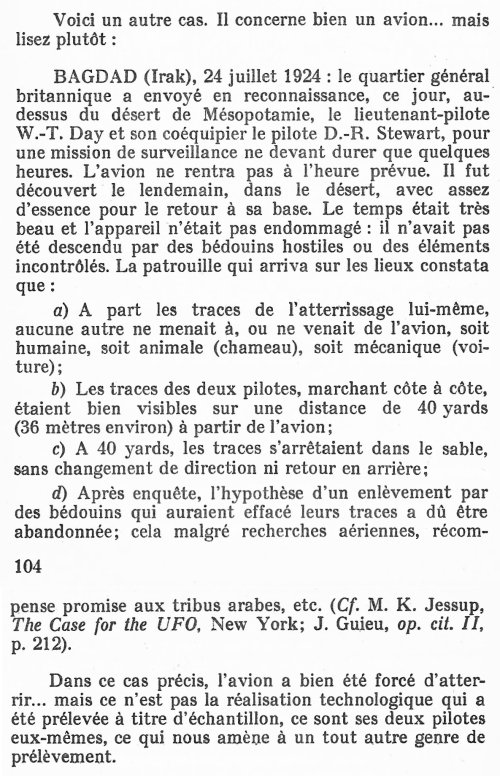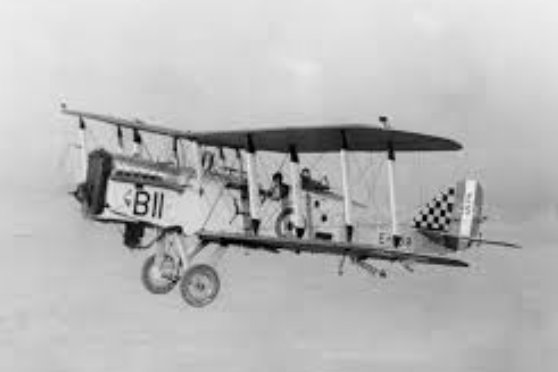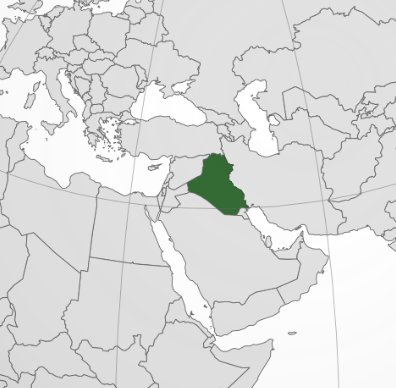ACUFO-1924-07-24-BAGDAD-1
Charles Hoy Fort (1874 - 1932), the famous American writer who collected "weird facts" that would show the incompleteness of science in his time, and later inspired "Fortean Researchers", reported in his fourth and last book, "Wild Talents", in 1932, a story he picked up in the newspaper London Sunday Express for September 21, 1924:
On July 24, 1924, Flight-Lieutenant W. T. Day and Pilot Officer D.R. Stewart were sent from British headquarters, upon an ordinary reconnaissance over a desert in Mesopotamia, Irak. They were supposed to be back in a few hours, but did not return.
They were searched for, the plane was soon found, it had landed in the desert for some unknown reason. The crew was missing, all that was found was about 40 meters of their footsteps, the tracks ended suddenly. There was still petrol left in the plane's tank, nothing wrong with the craft; which flown back to the aerodrome. The plane had not been shot down, the weather had been fine.
One thought Day and Stewart had been captured by hostile Bedouins who had brushed away all trails in the sand, but though it was impossible that they had brushed the trails indefinitely, the search found no renewal of the traces.
Aeroplanes, armored cars, mounted police searched; rewards were offered, tribal patrols searched unceasingly for four days, but the mystery of the missing British airmen still unsolved.
The story was picked up by Maurice K. Jessup in his 1955 UFO book, then the next years by the French UFO book writer Jimmy Guieu, then 1977 in a book by Frenchman "Henri Durrant" (Didier Serres), then in the 2000's in a Web UFO catalogue. Each one referred to the previous author rather than to the original sources.
All these sources suggested or seemed to suggest seemed that UFOs or extraterrestrial would have been involved in the plane's unexplained landing and the airmen's disappearance.
What Fort and all his copycats missed is that the two airmen had not really "vanished". The Press and the British authorities at the time indicated that they were eventually found. A five-minute search on the Internet shows that in March 1925, British newspapers reported that the Air Ministry had received "official intimation" that the skeletons of Day and Stewart had been found in the desert. The Lanarkshire, Scotland Sunday Post commented on March 8, 1925, that this "only adds to the baffling mystery of the officers' deaths, and to-day the Air Ministry could offer no theory as to how the officers met their fate." But it was suggested that the men had been forced to land their plane because of a sudden sandstorm, and contrary to the earlier reports about the disappearances, it was now said that when their plane had been discovered, it was "slightly damaged" and repairs had to be made on it before it could be flown back to where their squadron was stationed.
The newspapers stated that the bones of Flight-Lieutenant Day had been found in February. Stewart's were discovered some days later, at a spot five or six miles distant. After the bodies were identified as the missing pilots through dental records, they were buried in Basra with military honors.
It was theorized that Day had been slightly injured in the landing, as traces of blood were found on the plane, and that when the two men set out to hike to safety, he collapsed and died. Possibly Stewart pushed on in the hope that he might find help for his injured comrade, but he died from the heat... The earlier failure earlier to discover more of their footsteps traces and the remains was "probably due to the ever shifting sands, swept in storms across the desert."
There was an official military inquiry into the deaths, which came to this same conclusion.
A source specified that the two airmen were from No. 84 Squadron, and piloted a DH.9a aircraft on an armed desert patrol, searching for raiding party. The footprints found on 40 yards only were in the direction of Jalibah Railway Station, twelve miles due north. Some rations and a drum with 3.5 gallons of water was found in aircraft and from the position of the drum with the funnel resting on it the presumption was made that the two men had filled their water bottles before leaving. Traces of blood on the airplane suggested that Flight-Lieutenant Day had been slightly injured. Aeroplane magazine of March 18, 1925 stated that "remains recently discovered in the desert in Iraq" had been identified as being those of Day and Stewart, and it was concluded that they had lost their way and died of heat exhaustion.
| Date: | July 24, 1924 |
|---|---|
| Time: | ? |
| Duration: | N/A. |
| First known report date: | September 21, 1924 |
| Reporting delay: | Hours. |
| Country: | Irak |
|---|---|
| State/Department: | |
| City or place: | Near Jalibah Railway Station, near Baghdad. |
| Number of alleged witnesses: | 0 |
|---|---|
| Number of known witnesses: | 0 |
| Number of named witnesses: | 0 |
| Reporting channel: | The Press, Charles Fort. |
|---|---|
| Visibility conditions: | Clear weather. |
| UFO observed: | No. |
| UFO arrival observed: | N/A. |
| UFO departure observed: | N/A. |
| UFO action: | N/A. |
| Witnesses action: | |
| Photographs: | No. |
| Sketch(s) by witness(es): | No. |
| Sketch(es) approved by witness(es): | No. |
| Witness(es) feelings: | N/A. |
| Witnesses interpretation: | N/A. |
| Sensors: |
[ ] Visual:
[ ] Airborne radar: [ ] Directional ground radar: [ ] Height finder ground radar: [ ] Photo: [ ] Film/video: [ ] EM Effects: [ ] Failures: [ ] Damages: Death of two airmen. |
|---|---|
| Hynek: | N/A. |
| Armed / unarmed: | Armed, machine gun. |
| Reliability 1-3: | 1 |
| Strangeness 1-3: | 1 |
| ACUFO: | Not UFO-related. |
[Ref. cft1:] CHARLES FORT:
Upon July 24th, 1924, at a time of Arab-hostility, Flight-Lieutenant W.T. Day and Pilot Officer D.R. Stewart were sent from British headquarters, upon an ordinary reconnaissance over a desert in Mesopotamia. According to schedule, they would not be absent more than several hours. I take this account from the London Sunday Express, Sept. 21, 28, 1924.(2)
The men did not return, and they were searched for. The plane was soon found, in the desert. Why it should have landed was a problem. "There was some petrol left in the tank. There was nothing wrong with the craft. It was, in fact, flown back to the aerodrome." But the men were missing. "So far as can be ascertained, they encountered no meteorological conditions that might have forced them to land." There were no marks to indicate that the plane had been shot at. There may be some way, at present very exclusively known, of picking an aeroplane out of the sky. According to the rest of this story, there may be some such way of picking men out of a desert.
In the sand, around the plane, were seen the footprints of Day and Stewart. "They were traced, side by side, for some forty yards from the machine. Then, as suddenly as if they had come to the brink of a cliff, the marks ended."
The landing of the plane was unaccountable. But, accepting that as a minor mystery, the suggested explanation of the abrupt ending of the footprints was that Day and Stewart had been captured by hostile Bedouins, who had brushed away all trails in the sand, starting at the point [182/183] forty yards from the plane. But hostile Bedouins could not be thought of as keeping on brushing indefinitely, and a search was made for a renewal of traces.
Aeroplanes, armored cars, and mounted police searched. Rewards were offered. Tribal patrols searched unceasingly for four days. Nowhere beyond the point where the tracks in the sand ended abruptly, were other tracks found. The latest account of which I have record is from the London Sunday News, March 15, 1925 -- mystery of the missing British airmen still unsolved.(3)
[Ref. mjp1:] MAURICE K. JESSUP:
July 24, 1924, at a time of Arab Hostility, Flight-Lieutenant W. T. Day, and Pilot Officer, D. R. Stewart, were sent from British HQ upon an ordinary reconnaissance flight over a desert in Mesopotamia. According to the scheduled flight plan they would not be absent more than a few hours. I take this account from the London Sunday Express, Sept. 21, 28, 1924.
The men did not return, and they were searched for. The plane was soon found, in the desert. Why it should have landed was a problem. "There was some petrol left in the tank. There was nothing wrong with the craft. It was, in fact, flown back to the aerodrome." But the men were missing. "So far as can be ascertained, they encountered no meteorological conditions that might have forced them to land." There were no marks to indicate that the plane had been shot at. There may be some way, at present very exclusively known, of picking an aeroplane out of the sky. According to the rest of this story, there may be some such way of picking men out of a desert.
In the sand, around the plane, were seen the footprints of Day and Stewart. "They were traced, side by side, for some forty yards from the machine. Then, as suddenly as if they had come to the brink of a cliff, the marks ended."
The landing of the plane was unaccountable. But, accepting that as a minor mystery, the suggested explanation of the abrupt ending of the footprints was that Day and Stewart had been captured by hostile Bedouins, who had brushed away all trails in the sand, starting at the point forty yards from the plane. But hostile Bedouins could not be thought of as keeping on brushing indefinitely, and a search was made for a renewal of traces.
Aeroplanes, armored cars, and mounted police searched. Rewards were offered. Tribal patrols searched unceasingly for four days. Nowhere beyond the point where the tracks in the sand ended abruptly, were other tracks found. The latest account of which I have record is from the London Sunday News, March 15, 1925 - mystery of the missing British airmen still unsolved.
[Ref. jgu1:] JIMMY GUIEU:

|
We cannot further clarify the following mysterious double disappearance:
On July 24, 1924, Flying Lieutenant W.T. Day and Pilot Officer D. R. Stewart were sent by British HQ to carry out a reconnaissance flight over the Mesopotamian desert. They were only supposed to be absent for a few hours... but never returned.
Their plane was discovered in the desert, in perfect working order, with enough fuel to return to their base. Why did they land? The weather conditions were excellent. The aircraft had not been "shot down" (something which would have been possible because at that time Arab hostility reigned).
Investigators discovered, around the plane, traces of Day and Stewart walking side by side for a distance of 40 yards (36 meters).
Suddenly, the tracks stopped in the sand... just as if from there the pilots had been kidnapped in the air! The hypothesis that hostile Bedouins had kidnapped the aviators after having erased the traces was quickly rejected. For four days, methodical searches were undertaken by plane, by automobile, on horseback; scouts were sent among the Arab tribes; a strong reward was promised to the one or those who would find the two aviators, but in vain. We never found out what had become of them. (1)
We could cite many other mysterious and unexplained disappearances that occurred during the last century.
[...]
(1) Facts reported by M. K. Jessup in his book "The case for the U.F.O." (Published by The Citadel Press, New York).
[Ref. pgn1:] PATRICE GASTON:
This case is reminiscent of the mystery posed in the Mesopotamian desert on July 24, 1924.
That day, the plane of pilot lieutenant W.T. Day and pilot officer D.R. Stewart was found in perfect working order. The tracks of the two men moved away from the aircraft for a distance of 36 meters. Then, the tracks stopped abruptly, like those of the Brooke family who had abandoned their car at the side of the road... The search continued for four days, without any result.
The facts are quite clear, especially in this desert where there was no chance for these two men to survive, “unless they had been picked up by another aircraft”.
[Ref. hdt1:] "HENRI DURRANT":

|
Here is another case. It does indeed concern a plane... but just read:
BAGHDAD (Iraq), July 24, 1924: the British headquarters sent on reconnaissance today, above the desert of Mesopotamia, lieutenant-pilot W.-T. Day and his teammate, pilot D.-R. Stewart, for a surveillance mission expected to last only a few hours. The plane did not return at the scheduled time. It was discovered the next day, in the desert, with enough gasoline to return to its base. The weather was very good and the aircraft was not damaged: it had not been brought down by hostile Bedouins or uncontrolled elements. The patrol which arrived on the scene noted that:
a) Apart from the traces of the landing itself, no other one led to or came from the plane, either human, animal (camel), or mechanical (car);
b) The tracks of the two pilots, walking side by side, were clearly visible for a distance of 40 yards (approximately 36 meters) from the aircraft;
c) At 40 yards, the tracks stopped in the sand, without changing direction or turning back;
d) After investigation, the hypothesis of a kidnapping by Bedouins who erased their traces had to be abandoned; this despite aerial searches, reward promised to Arab tribes, etc. (Cf. M. K. Jessup, The Case for the UFO, New York; J. Guieu, op. cit. II, p. 212).
In this specific case, the plane was indeed forced to land... but it was not the technological achievement that was taken as a sample, it was its two pilots themselves, this which brings us to a completely different type of sampling.
[Ref. gvo1:] GODELIEVE VAN OVERMEIRE:
1924, July 24
IRAQ, Baghdad
The British headquarters sent over the desert of Mesopotamia, Pilot Lieutenant W. T. Day and Pilot Mate D. R. Stewart, for a surveillance mission, expected to last only a few hours. The plane did not return. It was discovered the next day in the desert, with enough fuel for the return. It was not damaged. Apart from the traces of the landing none led to or came towards the plane: neither human nor animal nor mechanical traces. The traces of both pilots, side by side were visible for 40 yards and stopped in the sand, without changing direction or going back. (Henry DURRANT: «Premières enquêtes sur les Humanoïdes ET» – Laffont 1977 – p. 104, 105) (vog note: no crash or loss of plane or of aviators on this date and in this place in the database
http://www.planecrashinfo.com/database.htm Copyright ©1997-2004 Richard Kebabjian)
[Ref. scy1:] "STRANGE COMPANY" BLOG:
Monday, April 28, 2014
The mystery involving Flight-Lieutenant William Conway Day (his name is usually erroneously given as "W.T. Day,") and Pilot Officer Douglas Ramsay Stewart retains a lasting fame largely through its inclusion in Charles Fort's influential book "Wild Talents." In 1924, the two members of the Royal Air Force were stationed in Iraq, where their main duty was to make routine reconnaissance flights.
On July 24, the two men set out on one of these missions, which was to take about three hours. They never returned.
When a search party set out for them, their plane was easily found. It had been parked - not crashed - on the desert floor. There was gas in the tank, and the plane was undamaged. Extra clothing and water supplies were still in the plane. The only things missing from the craft were its pilots.
No reason could be found why the men should have landed. The weather had been good, and there were no signs of any attack. Footprints of both men could be clearly seen around the plane. They had evidently walked side by side for about forty yards away from their plane. Then, the prints abruptly ceased.
All anyone could imagine was that the pilots had been kidnapped by Bedouins, who then used implements to carefully wipe out their tracks. It was pointed out at the time that this made little sense. If they wished to remove footprints, why not destroy all of them? Since they could not keep up this erasing technique indefinitely, why were no other prints found anywhere in the area? And this theory still failed to answer the initial mystery: Why did the men land in the first place?
Still, that was the only relatively sane explanation anyone could concoct for the disappearance of the men, so they stubbornly stuck to it. An extensive search was made in the region, and the local tribesmen were offered a reward for any information about the vanished pilots, but it all proved to be an utter waste of time. The men, or any clues to their fate, could not be found.
When I wrote the first draft of this post, I assumed that Fort was correct when he described Day and Stewart's disappearance as an unsolved mystery. However, while searching through old newspaper databases, I discovered that in March of 1925, British papers reported that the Air Ministry had received "official intimation" that the skeletons of Day and Stewart had been found in the desert. As the Lanarkshire, Scotland "Sunday Post" commented on March 8, "This only adds to the baffling mystery of the officers' deaths, and to-day the Air Ministry could offer no theory as to how the officers met their fate."
It was suggested that the men had been forced to land their plane because of a sudden sandstorm. Contrary to the earlier reports about the disappearances, it was now said that when their plane had been discovered, it was "slightly damaged" and repairs had to be made on it before it could be flown back to where their squadron was stationed.
The newspapers stated that the bones of Flight-Lieutenant Day had been found in February. Stewart's were discovered some days later, at a spot five or six miles distant. After the bodies were identified as the missing pilots through dental records, they were buried in Basra with military honors.
It was theorized that Day had been slightly injured in the landing, (traces of blood were found on the plane,) and that when the two men set out to hike to safety, he collapsed and died. "Then possibly Stewart pushed on in the hope that he might find help for his injured comrade, only himself to be overcome by the heat...The failure earlier to discover the remains was probably due to the ever shifting sands, swept in storms across the desert." There was an official military inquiry into the deaths, which evidently came to this same conclusion.
It seems that this near-legendary Fortean tragedy, which has spawned speculation about everything from underground caverns to UFO abductions, had a simple, if somewhat curious explanation, which was well-known at the time, but has since been forgotten and overlooked.
[Ref. hhy1:] HUGH A. HALLIDAY:
DAY, William Conway, F/L MC - death presumed 25 July 1924 - No.84 Squadron, DH.9a H47. Aircraft on an armed desert patrol, searching for raiding party. Landed in the desert for unknown reasons, morning of 24 July 1924 and was found by searching machines that afternoon. Footprints were traceable for about 40 yards in the direction of Jalibah Railway Station, twelve miles due north. Some rations and a drum with 3 ½ gallons of water found in aircraft and from the position of the drum with the funnel resting on it the presumption was made that the two men had filled their water bottles before leaving. Traces of blood on the machine suggested that F/L Day had been slightly injured, but no message was left behind. Aeroplane of 18 March 1925 stated that “remains recently discovered in the desert in Iraq” had been identified as being those of Day and Stewart. It was concluded that they had lost their way and died of heat exhaustion; death was dated the day after they had force-landed.
Below: Royal Air Force Airco DH.9a.

|

|
The sources are clear. There was no UFO and no alien abduction here.
Not UFO-related.
* = Source is available to me.
? = Source I am told about but could not get so far. Help needed.
| Main author: | Patrick Gross |
|---|---|
| Contributors: | None |
| Reviewers: | None |
| Editor: | Patrick Gross |
| Version: | Create/changed by: | Date: | Description: |
|---|---|---|---|
| 0.1 | Patrick Gross | June 28, 2024 | Creation, [cft1], [mjp1], [jgu1], [hdt1], [gvo1], [scy1], [hhy1]. |
| 1.0 | Patrick Gross | June 28, 2024 | First published. |
| 1.1 | Patrick Gross | August 1, 2024 | Addition [pgn1]. |